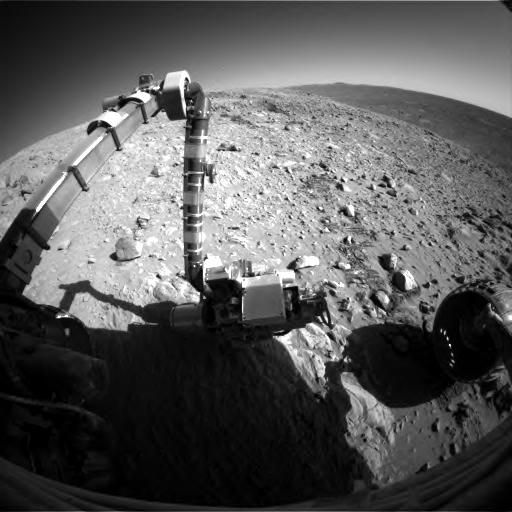NASA Rover Hits the One-Year Mark on Mars

This story was updated at 4:00 p.m. EST.
Sitting on the hill of an alien world millions of miles from home, a hardy NASA robot celebrates an anniversary today - one year on the planet Mars.
The Mars rover Spirit has come a long way since it hurtled down through the planet's atmosphere and came to a bouncy, airbag-protected stop at Gusev Crater on Jan. 3, 2004. It has survived more than four times its initial 90-day mission, driven miles across the Martian landscape and weathered a red planet winter only to scale hills for its human handlers.
"I never, ever would have imagined that I would have the opportunity to be standing here a year later and say we're back and still on Mars," said NASA's top administrator Sean O'Keefe today during a press conference at the Jet Propulsion Laboratory (JPL) in Pasadena, California. "What the exploration team has done in the last 12 months is absolutely nothing short of remarkable."
O'Keefe spoke during a full day of storytelling, reflection and news conferences commemorating Spirit's first year exploring Mars. Mission managers, scientists and engineers clapped loudly in a JPL auditorium as O'Keefe blew out the birthday candle atop Spirit's birthday cake.
"This has been a stressful year...but both rovers have been very successful," said Jim Erickson, project manager for the rover mission at JPL, during the press briefing. "Bad things could happen to us at any time, but as long as we have them we're going to keep using them to the best of their abilities."
A continuing mission
Get the Space.com Newsletter
Breaking space news, the latest updates on rocket launches, skywatching events and more!
Spirit continues to return science information from the Columbia Hills, after driving 2.4 miles (4 kilometers) from its Gusev Crater landing site. Scouring those hills has given Spirit - and researchers - more evidence that water shaped Mars' past. Meanwhile, on the other side of Mars at Meridiani Planum, Spirit's robotic twin Opportunity is studying its own heat shield while it seeks to dig more details on the area's watery past.
"It's astonishing to me how well it's going," said Steve Squyres, principal investigator for the Mars Exploration Rover (MER) project from Cornell University, of the mission before today's anniversary. "They're tough machines built by a fantastic team."
During today's briefing, Squyres said that working with Spirit and Opportunity has been "the adventure of a lifetime" for both himself and the mission team.
Some hitches on the way
A software problem dogged Spirit in the early weeks of its mission when it fell silent for a period, but engineers were able to work through the glitch and resume the rover's science mission.
"That was waiting to bite us," Squyres said of the glitch, which involved Spirit's flash memory and required updated software to fix. "If Opportunity had landed first, it would have had the same problem."
Spirit has experienced other quirks, such as a finicky wheel that has left it dependent on only five of its six wheels to rove about Mars. But the glitch has not prevented to rover from slowly making its way up "Husband Hill" in the Columbia Hills.
"Spirit is our tough, hardworking robot," Squyres said, adding the rover is scratched and dusty. "Opportunity looks like she just came off the showroom floor, clean and pretty."
Squyres and other mission team members have become so adept at handling Spirit and Opportunity from Earth, they no longer need to congregate together at NASA's Jet Propulsion Laboratory (JPL) to plan out each moment of each rover's day. Instead, telephone and video conferences allow researchers to operate the rovers remotely.
"From an engineering standpoint, you really have to tip your hat," JPL's Matt Golombek told SPACE.com. "These rovers were designed for a lifetime of three months and now it's not clear when they're going to stop."
Looking ahead
Mission scientists said the next stop for Spirit is a region dubbed Cumberland Ridge where they hope the rover will find more rocks akin to the rock target "Wishstone", a phosphorous-rich object that unlike the surrounding Columbia Hills material.
"The first message is that this is dramatically different than anything we've seen," Squyres said.
Meanwhile, Opportunity will continue its heat shield studies and hopefully return information that could hopefully help engineers design better versions for future spacecraft. Once finished, Opportunity is expected to hopscotch across Merdiani Planum, moving from crater to crater until it reaches a circular feature dubbed "Vostok", which may or may not be an actual crater.
"We don't know if it's a strangely eroded impact crater or what," Squyres said of the object.
- Mars Rovers: Special Report
Join our Space Forums to keep talking space on the latest missions, night sky and more! And if you have a news tip, correction or comment, let us know at: community@space.com.

Tariq is the Editor-in-Chief of Space.com and joined the team in 2001, first as an intern and staff writer, and later as an editor. He covers human spaceflight, exploration and space science, as well as skywatching and entertainment. He became Space.com's Managing Editor in 2009 and Editor-in-Chief in 2019. Before joining Space.com, Tariq was a staff reporter for The Los Angeles Times covering education and city beats in La Habra, Fullerton and Huntington Beach. In October 2022, Tariq received the Harry Kolcum Award for excellence in space reporting from the National Space Club Florida Committee. He is also an Eagle Scout (yes, he has the Space Exploration merit badge) and went to Space Camp four times as a kid and a fifth time as an adult. He has journalism degrees from the University of Southern California and New York University. You can find Tariq at Space.com and as the co-host to the This Week In Space podcast with space historian Rod Pyle on the TWiT network. To see his latest project, you can follow Tariq on Twitter @tariqjmalik.









